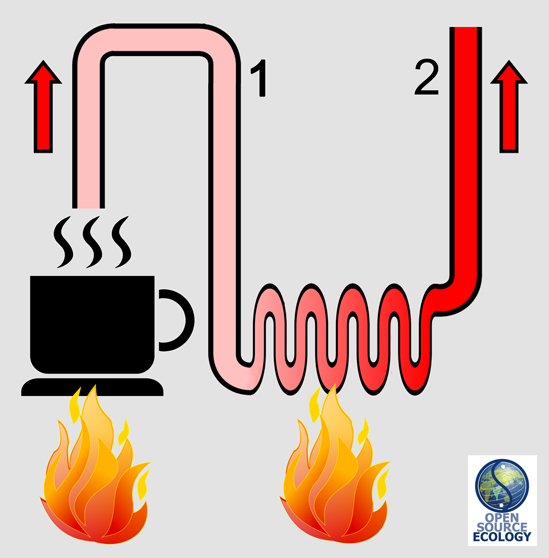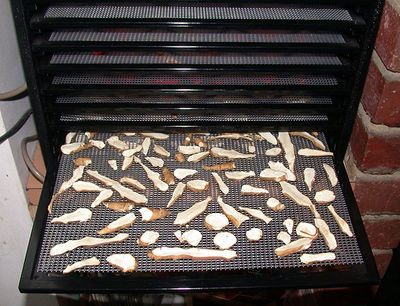Food Drying with Superheated Steam: Difference between revisions
(Created page with "{{Category=Food Storage and Processing}} 400px|thumb|right|Excalibur Drying Jerusalem Artichokes [http://en.wikipedia.org/wiki/Superheated_steam Super-...") |
mNo edit summary |
||
| (33 intermediate revisions by 2 users not shown) | |||
| Line 1: | Line 1: | ||
{{Category=Food Storage and Processing}} | {{Category=Food Storage and Processing}} | ||
[[File: | [[File:Superheated steam.jpg|549px|thumb|right|Principle of superheated steam: Water is heated in a boiler, generating saturated steam (1). It is then heated further in a“superheater” and is then (2) able to absorb additional moisture. ]] | ||
[http://en.wikipedia.org/wiki/Superheated_steam Super-heated or dry steam] has the ability to drive moisture out of solid materials much faster and more cost-effectively than air drying | [http://en.wikipedia.org/wiki/Superheated_steam Super-heated or dry steam] has the ability to drive moisture out of solid materials much faster and more cost-effectively than air drying while being gentler on the end product. This technology is getting a lot of interest in the food industry and could become the drying and frying technology of choice. It is far more cost effective and has lower technology requirements than [[Freeze_Dried_Fruit_Powders| freeze drying]]. This technology has the potential to improve rural incomes by capturing the added value from food processing ''on the farm''. In addition to drying, the process can also sterilize the product, which is an important food safety feature or in processes with subsequent fermentation. | ||
It also has advantages in terms of nutrient preservation. There is no free oxygen in superheated steam, so the decomposition of easily oxidized nutrients such as vitamin C is reduced. This is a key advantage over food drying with hot air. Another advantage is that this process is much faster than traditional (solar) food drying, which is crucial when large volumes of one particular crop need to be processed at harvest time (think: tomatoes, strawberries, raspberries - these are all high value products when | It also has advantages in terms of nutrient preservation. There is no free oxygen in superheated steam, so the decomposition of easily oxidized nutrients such as vitamin C is greatly reduced. This is a key advantage over food drying with hot air, which exposes the food to oxygen. (Aside: most people think that it's the heat that destroys nutrients in food, while it's actually the oxygen. This has been demonstrated with canned food, which often has very good nutrient preservation). Another advantage is that this process is much faster than traditional (solar) food drying, which is crucial when large volumes of one particular crop need to be processed at harvest time (think: tomatoes, strawberries, raspberries, blackberries - these are all high value products when dry, and are easily transported, easily traded). By applying lower than normal pressure, it is possible to use temperatures far lower than 100°C (212°F), and as low as 45°C (113°F) for heat-sensitive foods. | ||
Sources of energy (heat) are solar (weather permitting) and biomass, possibly in combination (day/night) for more reliability. When the heat source is [[pyrolysis]] (with [[biochar]] as a by-product) rather than combustion, the process can be made truly carbon negative, i.e. it actually pulls carbon out of the atmosphere every time you use it. | |||
[[File:Food dryer.jpg|400px|thumb|right|Excalibur Drying Jerusalem Artichokes]] | |||
==Examples: Food== | ==Examples: Food== | ||
* | * vegetables & fruits | ||
* base materials: hog fuel, corn fibres, protein containing base materials (soy beans, rape seed, sunflower seed, soy meal, | * potato products (e.g. powder, fries, potato waste) | ||
* | * sugars/starches: sugar beet pulp, fibre from sugar beet | ||
* | * grains (e.g. wheat - replaces traditional gas-fired grain dryer), wheat flour | ||
* spent distillers grain, brewers grains | |||
* [[duckweed]] and [[azolla]]: could dry with SHS but better alternative: lactoferment/sauerkrautify | |||
* dairy industry: milk powder, flash drying | * other: coffee grounds, spices, linseed, sunflower seed | ||
* base materials: hog fuel, corn fibres, protein containing base materials (soy beans, rape seed, sunflower seed, soy meal, okra, etc.) | |||
* bamboo shoots, paddy/rice, herbs, cacao beans, corn gluten, tobacco (drying, expansion) | |||
* beef (i.e. jerky), meat (pork), bone meal, fish meal, shrimp | |||
* dairy industry: milk powder, flash drying, yogurt dehydration | |||
==Examples - other (non-food) == | ==Examples - other (non-food) == | ||
* biofuel: drying and grinding of sugary biomass for pre-processing before fermentation | * biofuel: drying and grinding of sugary biomass for pre-processing before fermentation | ||
* biomass: sawdust, wood | * biomass: straw, sawdust, wood fiber, wood chips, wood pulp, spruce and birch bark, milled peat, peat for briquettes | ||
* agriculture: for use in a [[Steam Weeder]] and sterilizer: Steam can be an effective alternative to chemicals in agriculture. Superheated steam can be used to kill weeds (alternative to herbicides). In soil steaming, steam is injected into the soil, killing pathogens. | |||
* chemical industry: washing powder, pigment, potassium salt, powdery chemicals, catalysts, coloring agents | * chemical industry: washing powder, pigment, potassium salt, powdery chemicals, catalysts, coloring agents | ||
* chemical processing - reaction kinetics manipulation | |||
* laundry, dry cleaning | * laundry, dry cleaning | ||
* textile applications (coated) textile, drying | * textile applications (coated) textile, drying | ||
* | * wood, lime mud (before calcination), mineral wool, fibres, cement curing | ||
* paper, pulp, sludge | * building materials | ||
* | * paper, pulp, sludge, other cellulose derivatives (such as [[nanocellulose]]) | ||
* sewage sludge, manure, grass | |||
==Alternatives== | |||
Compare to: [[Freeze Drying]] | |||
Comment by Vanita Shanti Luxul (CFO and Co-Founder at Giving Pathways Foundation, Agroforestry Ecological Land Trust): ''"We have used a Excalibur dehydrator before. Advantage in the method you suggested [superheated steam, RK] is cost effective and has lower technology requirements than freeze drying. In comparison freeze drying retains original shape, rehydrates foods better, preserves more nutrients and can have a shelf life of up to 25 years using #10 cans."'' | |||
== Links == | |||
* book chapters: [http://gasunie.eldoc.ub.rug.nl/FILES/root/2004/3337003/3337003.pdf "Industrial Superheated Steam Drying"] | |||
* Publication: [http://www.bioeng.ca/pdfs/meeting-papers/2005/CSAE%20papers/05-009.pdf "SUPERHEATED STEAM: ITS NOT JUST ABOUT DRYING"] | |||
* Publication: [http://www.engr.usask.ca/societies/csae/c9914.pdf "Dehydration dynamics of potatoes in superheated steam and hot air"] | |||
* Publication: [http://www.sciencedirect.com/science/article/pii/S0260877406007230 "Decontamination of food products with superheated steam"] | |||
* Review paper: [http://www.idosi.org/wjdfs/wjdfs5(2)/17.pdf Superheated Steam Drying of Foods-A Review] | |||
Latest revision as of 13:42, 9 May 2017
Main > Food and Agriculture > Food Storage and Processing
Super-heated or dry steam has the ability to drive moisture out of solid materials much faster and more cost-effectively than air drying while being gentler on the end product. This technology is getting a lot of interest in the food industry and could become the drying and frying technology of choice. It is far more cost effective and has lower technology requirements than freeze drying. This technology has the potential to improve rural incomes by capturing the added value from food processing on the farm. In addition to drying, the process can also sterilize the product, which is an important food safety feature or in processes with subsequent fermentation.
It also has advantages in terms of nutrient preservation. There is no free oxygen in superheated steam, so the decomposition of easily oxidized nutrients such as vitamin C is greatly reduced. This is a key advantage over food drying with hot air, which exposes the food to oxygen. (Aside: most people think that it's the heat that destroys nutrients in food, while it's actually the oxygen. This has been demonstrated with canned food, which often has very good nutrient preservation). Another advantage is that this process is much faster than traditional (solar) food drying, which is crucial when large volumes of one particular crop need to be processed at harvest time (think: tomatoes, strawberries, raspberries, blackberries - these are all high value products when dry, and are easily transported, easily traded). By applying lower than normal pressure, it is possible to use temperatures far lower than 100°C (212°F), and as low as 45°C (113°F) for heat-sensitive foods.
Sources of energy (heat) are solar (weather permitting) and biomass, possibly in combination (day/night) for more reliability. When the heat source is pyrolysis (with biochar as a by-product) rather than combustion, the process can be made truly carbon negative, i.e. it actually pulls carbon out of the atmosphere every time you use it.
Examples: Food
- vegetables & fruits
- potato products (e.g. powder, fries, potato waste)
- sugars/starches: sugar beet pulp, fibre from sugar beet
- grains (e.g. wheat - replaces traditional gas-fired grain dryer), wheat flour
- spent distillers grain, brewers grains
- duckweed and azolla: could dry with SHS but better alternative: lactoferment/sauerkrautify
- other: coffee grounds, spices, linseed, sunflower seed
- base materials: hog fuel, corn fibres, protein containing base materials (soy beans, rape seed, sunflower seed, soy meal, okra, etc.)
- bamboo shoots, paddy/rice, herbs, cacao beans, corn gluten, tobacco (drying, expansion)
- beef (i.e. jerky), meat (pork), bone meal, fish meal, shrimp
- dairy industry: milk powder, flash drying, yogurt dehydration
Examples - other (non-food)
- biofuel: drying and grinding of sugary biomass for pre-processing before fermentation
- biomass: straw, sawdust, wood fiber, wood chips, wood pulp, spruce and birch bark, milled peat, peat for briquettes
- agriculture: for use in a Steam Weeder and sterilizer: Steam can be an effective alternative to chemicals in agriculture. Superheated steam can be used to kill weeds (alternative to herbicides). In soil steaming, steam is injected into the soil, killing pathogens.
- chemical industry: washing powder, pigment, potassium salt, powdery chemicals, catalysts, coloring agents
- chemical processing - reaction kinetics manipulation
- laundry, dry cleaning
- textile applications (coated) textile, drying
- wood, lime mud (before calcination), mineral wool, fibres, cement curing
- building materials
- paper, pulp, sludge, other cellulose derivatives (such as nanocellulose)
- sewage sludge, manure, grass
Alternatives
Compare to: Freeze Drying
Comment by Vanita Shanti Luxul (CFO and Co-Founder at Giving Pathways Foundation, Agroforestry Ecological Land Trust): "We have used a Excalibur dehydrator before. Advantage in the method you suggested [superheated steam, RK] is cost effective and has lower technology requirements than freeze drying. In comparison freeze drying retains original shape, rehydrates foods better, preserves more nutrients and can have a shelf life of up to 25 years using #10 cans."
Links
- book chapters: "Industrial Superheated Steam Drying"
- Publication: "SUPERHEATED STEAM: ITS NOT JUST ABOUT DRYING"
- Publication: "Dehydration dynamics of potatoes in superheated steam and hot air"
- Publication: "Decontamination of food products with superheated steam"
- Review paper: Superheated Steam Drying of Foods-A Review

